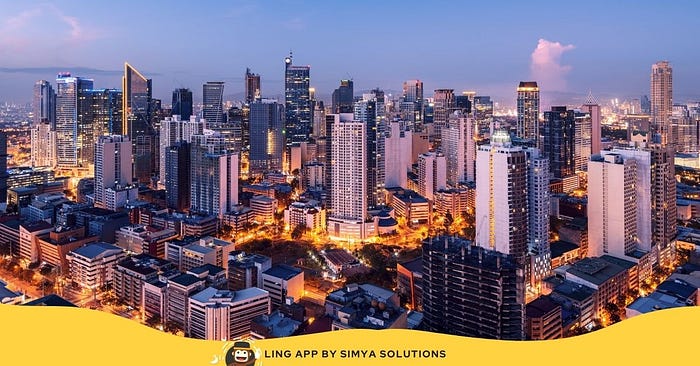The 17 Regions In The Philippines: An Easy Review
Original blog post: https://ling-app.com/fil/regions-in-the-philippines/

Planning to visit different rehiyon (in Tagalog) or regions in the Philippines? If you are, then you learning about the regions and precisely where it is located will greatly help you, especially if you are creating an itinerary. In as much as you want to visit Boracay and Baguio at the same time, such a route is impossible if you will only be staying in the country for a few days. Instead of “winging” it, why not try to look for other tourist destinations that are in the same region, right? Let’s learn more about that in this post!
Whenever one thinks about the beauty of the Philippines, what usually comes to mind are secluded islands where you can dip your toes into some of the best beaches there is in the world. For those in the business and who are looking for jobs, perhaps you also know about the city of Manila (popularly known as Metro Manila), Quezon City, and other popular cities in Luzon. However, this archipelagic country might surprise you since it has tons of places where you can go despite its small land area.
But before we proceed with the discussion, allow me to give you a quick trivia: did you know that the concept of regions only came into existence in 1972? Thanks to President Ferdinand Marcos, he signed the presidential decree that stipulates divided the entire country. Back then, the regions were only 11, each with its own regional center.
The following year, the country was further divided into 12 since Region IV was divided into two: CALABARZON and MIMAROPA. In 1978, the Metropolitan Manila was rebranded as the National Capital Region. During the presidency of President Corazon Aquino, an executive order was signed to create the Cordillera Administrative Region and the Autonomous Region In Muslim Mindanao (or ARMM).
From 2002 to 2018, all the presidents amended the regional designation to the point that our latest count reached up to 17 regions. Let’s get to know more about that below.
The Regions In The Philippines

The country has three major island groups known as Luzon, Visayas, and Mindanao. Luzon has 8 regions under its belt, while the Visayas has 3 and the Mindanao has 6. Presently, two types of regions exist in the Philippines, including the administrative region (geographically adjacent regions) and the autonomous region (sub-national administrative division).
Region I — Ilocos Region
Region I is one of the many administrative regions in the country occupying a huge chunk of the northwestern part of Luzon. It is directly facing the South China Sea and it has four major provinces including the following:
- Ilocos Norte
- Ilocos Sur
- La Union
- Pangasinan
Region II — Cagayan Valley
Found in the coastal part of Luzon, the Cagayan valley region cover five provinces including the following:
- Batanes
- Cagayan
- Nueva Vizcaya
- Isabela
- Quirino
Region III — Central Luzon
The Central Luzon region represents over 19% of the overall population in all of Luzon. It has 116 municipalities and it includes these seven provinces:
- Bataan
- Bulacan
- Aurora
- Tarlac
- Pampanga
- Zambales
- Nueva Ecija
National Capital Region
Also known as the Metropolitan Manila, the NCR is branded as the seat of the government. It is made up of 16 populous cities including Manila, Quezon City, Makati, Las Pinas, Malabon, Muntinlupa, Mandaluyong, Marikina, Navotas, Pasa, Pasig, Paranaque, San Juan, Venezuela, and Taguig
Region IV A- CALBARZON
Boasting almost 4ooo barangays (or districts), this region has 5 provinces including 1 highly urbanized city:
- Cavite
- Laguna
- Batangas
- Quezon
- Rizal
Region IV B — MIMAROPA Region
With 71 municipalities and 2 major cities, the MIMAROPA region includes the following:
- Occidental Mindoro
- Oriental Mindoro
- Marinduque
- Palawan
- Romblon
Region V — Bicol Region
An administrative region with over 107 municipalities and 3.4k barangays, the Bicol region has 6 major provinces including:
- Albay
- Camarines NOrte
- Camarines Sur
- Catanduanes
- Sorsogon
- Masbate
Region VI — Western Visayas
With 117 municipalities and 16 cities under its belt, this region is the home to 6 provinces including:
- Aklan
- Antique
- Capiz
- Guimaras
- Iloilo
- Negros Occidental
Region VII — Central Visayas
Situated in the central section of the Visayas island, this region is the cradle of four provinces including:
- Bohol
- Cebu
- Negros Oriental
- Siquijor
Region VIII — Eastern Visayas
This region has 136 municipalities along with 7 major cities. It is the home to six provinces including:
- Biliran
- Leyte
- Eastern Samar
- Northern Samar
- Samar
- Southern Leyte
Region IX — Zamboanga Peninsula
This coastal region with 1.9k barangays is also the home to three provinces such as:
- Zamboanga del Norte
- Zamboanga del Sur
- Zamboanga Sibugay
Region X — Northern Mindanao
With 84 municipalities and over 2000 barangays, Northern Mindanao covers five provinces including:
- Bukidnon
- Camiguin
- Lanao del Norte
- Misamis Occidental
- Misamis Oriental
Region XI — Davao Region
Bordered by the Philippine Sea and the Davao Gulf, the Davao region has 5 major provinces including:
- Davao de Oro
- Davao del Norte
- Davao Occidental
- Davao Oriental
- Davao del Sur
Region XII — SOCCSKSARGEN
With over 45 municipalities and 5 cities, this region is situated in central Mindanao and has four provinces:
- Cotabato
- South Cotabato
- Sultan Kudarat
- Sarangani
Region XIII — Caraga
This region has 67 municipalities and 5 major provinces including the following:
- Agusan del Norte
- Agusan del Sur
- Dinagat Isands
- Surigao del Sur
- Surigao del Norte
CAR — Cordillera Administrative Region
The CAR boasts 2 cities, 75 municipalities, and 6 provinces including:
- Abra
- Apayao
- Ifugao
- Benguet
- Mountain Province
- Kalinga
BARMM — Bangsamoro Autonomous Region In Muslim Mindanao
Directly in front of the Sulu Sea and the Celebes Sea, the BARMM is the home to five provinces including:
- Basilan
- Lanao del Sur
- Maguindanao
- Sulu
- Tawi-tawi
5 Most Populated Provinces In The Philippines

According to the census of the Philippine Statistics Authority, the republic of the Philippines population is on the rise. The 5 most populous provinces include Cebu (from Western Visayas) with almost 5.2 million people, followed by Cavite (Region IV-A) with 4.5 million, Bulacan (Central Luzon) with 3.7 million, Laguna (Region IV-A) with 3.38 million, and Rizal (Region IV-A) with 3.3 million.
Perhaps by now, you are also pondering on the question, “what are places in the country that has a small population?” To answer your question, the small provinces of Siquijor, Camiguin, and Dinagat Islands remain to have the smallest population ever.
Wrapping Up

As we reach this part of the post, we hope that you were able to learn about the different provinces located in the Philippines. While the whole country looks small from the maps, perhaps you found yourself surprised to know that there are 17 regions in it. If you enjoyed this post and figured that you would love to learn more about the regions of the Philippines, its culture, and its language, then you better check out our previous posts here.
But if you are someone who is more passionate about getting to know the language of the country, then we’ve got the best language learning tools that will fit your needs. Want to get FREE access to high-quality lessons and interactive language quizzes and games? You should not miss out on our most recommended application.
Ready To Learn Tagalog?

When it comes to mastering Tagalog and 60+ foreign languages, nothing can beat the platform of the Ling App by Simya Solutions. Accessible on both the website and mobile device, the Ling App gives users instant access to language learning modules that are created by real native speakers and language professionals who truly understand your learning needs.
Instead of bombarding you with tons of vocabulary lists at once, our team made the whole process entertaining in order to ensure that you won’t feel overwhelmed or bored. On top of that, you can easily practice learned information by using the embedded AI chatbot. This unique feature allows you to speak as if you are talking with a real native speaker.
Given its impressive modules and features, the community of users is just growing by the minute! In fact, even the AppStore recognized the Ling App! So, what are you waiting for? Download it today and start learning on the right foot!
